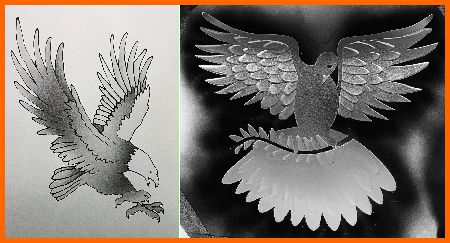You have seen elegant etched glass in museums and luxury residences and you would like to commission a window for your own home. But you have no idea of how to go about the commissioning process. Learn all you need to know about how how to commission an etched glass window in this useful guide.
The steps involved in commissioning an etched glass window are:
- Establish a budget
- Choose a glass studio
- Consult with the glass artist
- Decide on your design
- Approve the finished panel
- Approve the installation
As an Amazon Associate, I earn from qualifying purchases
1) Establish a budget
It’s a good idea to decide ahead of time roughly how much money you wish to spend on your etched glass window. A reputable glass studio will not take advantage of your honesty if you tell them your budget ahead of time.
Knowing the budget will save time and enable the artist to guide you towards the optimum design.
The cost of an etched glass commission is made up of four charges:
Design charge

Measuring charge

Money-saving strategy #1: reduce artwork charges by providing black & white line art or camera-ready vector files (ai or pdf).
Money-saving strategy #2: if you are handy and can measure and install your own panel. Artistry in Glass will provide expert advice.
Fabrication charge

Fabrication is the sum of the glass cost (materials) and the labor cost of sandblasting.
Installation charge
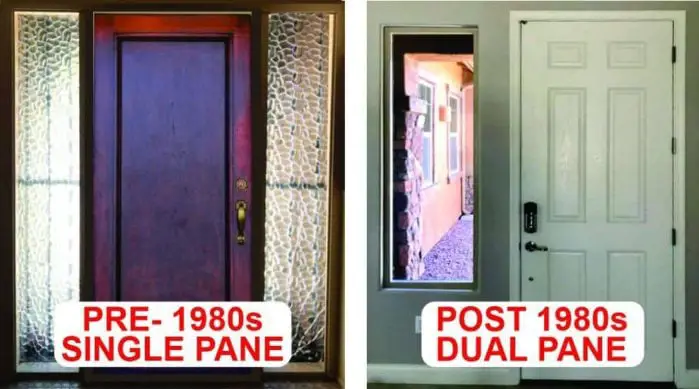
The delivery charge depends on the distance to the glass studio and installation varies depending on the age of the windows.
Glass types used for etching
Sandblast etching can be done on a variety of types of glass, clear or tinted, annealed or tempered, thick or thin. It can also form single-paned or dual-paned units. Jump to this section for more details.
To get ballpark estimates for different windows types, jump to these handy price calculators. Once you have done this homework, decide how much money you are comfortable spending.
Money-saving strategy #3
If a custom etched glass panel is too pricey for your budget, and you really need privacy – consider using affordable window film.
Can’t justify the cost of custom etched glass? Save money with this highly-rated frosted film available on Amazon. Clean your window thoroughly and spray with soapy water – smooth the film with a squeegee.
2) Choose a glass studio
Local or national company – which is better?
There are many excellent glass etching studios that will ship panels nationwide including one of our favorites – San Souci Glass in California. Many of them will do a great job but we highly recommend that you choose a local company whenever possible.
This is because art glass is a highly subjective process and we feel strongly that a personal relationship should be established between the artist and her client. This relationship is best nurtured on a face-to-face basis.
For this reason, at Artistry in Glass, we restrict our commissions to Southern Arizona customers.
As a side benefit, we derive much of our job satisfaction from seeing the delight and gratitude in the eyes of the customer after a successful project.
Installation: an important benefit of using a local company is that, in addition to saving shipping charges, the glass studio will guarantee the important tasks of measuring your windows and installing the art glass correctly – saving you the worry and inconvenience of hiring a separate contractor.
So, choose Artistry in Glass if you live in Southern Arizona but otherwise go with a company in your area.
Which studio to choose?
Competence: Take a look at the studio’s website to see examples of the quality and artistry of their work, check how long they have been in business, whether they have a public studio (rather than working from home),
Testimonials: check their Google testimonials to get real-life customer reviews.
Visit the studio to examine the quality and scope of their work. Do they do all their work “in-house” and do they have their own installers?
Empathy: make an appointment to talk to the glass artist to see whether you “get along” – it is crucial that you establish an empathetic working relationship and that you are confident that the studio will listen carefully to you and will have your interests at heart.
3) Consult with your glass artist
Before consulting your glass artist, educate yourself about the etched glass process by studying these blog posts:
- What is the difference between sandblasting and etching?
- What are the benefits of etched glass?
- How much does etched glass cost?
Then take the time to answer the questions on this list:
- Size & Shape of the window(s) – rectangle, arch, circle, single-pane, or IG
- Function – privacy, view control, home improvement, beauty
- Style – Southwestern, contemporary, mission, country, traditional
- Complexity – simple & functional or “work of art”
- Budget – approximately how much do you want to spend?
Explaining the details of your project in this organized manner will convince your glass artist that you are a serious customer and also enable her to give you the benefit of her expertise – thereby saving time and money.
Collaborating with your glass artist
The commissioning process will proceed much more smoothly if you communicate your requirements clearly to the glass artist. She has designed hundreds of panels and will be able to give you valuable, professional answers to all your questions.

Insider design tip: do not send photos of furry animals to your glass artist! This type of artwork is very expensive to process for etching – always send line art.
Design Choice: based on your input, your glass artist will produce scaled drawings for you to review. Old-school artists use paper and pencils whereas new-school, computer-savvy, designers use CAD software. In either case, feel free to express your opinions and request design changes.
For tips on making your own decisions on design style – read on!
4) Decide on your design
The style of etching is your most important decision because the cost of the project depends mainly on the time taken to do the work. Four main styles can be distinguished – in order of cost from inexpensive to expensive:
- Simple frosting
- Shaded etching
- Deep carving
- Carving with color
Generally speaking, simple frosted designs are the most affordable, and deeply carved designs are the most expensive. Jump to this post to see how the type of etching controls the price of the panel.
Simple Frosting
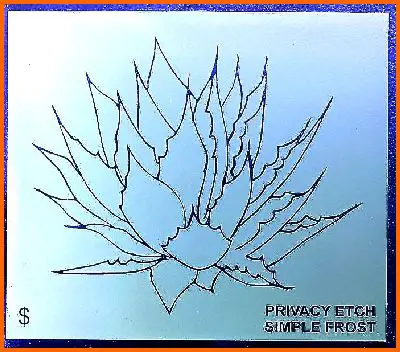
Simple frosted glass is the most affordable etching option because it is a one-stage, sandblasting process. Even though inexpensive, bold designs are impressive.
Choose this option if budget is an issue and your main requirement is privacy.
Shaded etching
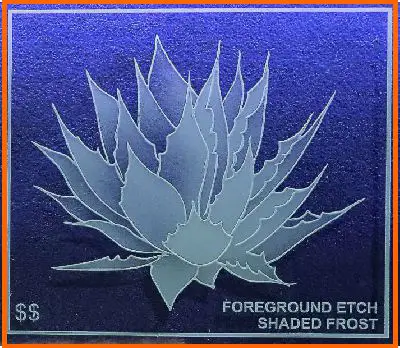
In shaded etching, individual design elements (for example, leaves) are variably etched (from white to black) in a manner similar to air-brush painting. The result is an artistic effect that adds depth to the design.
Choose this option to add flair to your etched panel
Deep carving
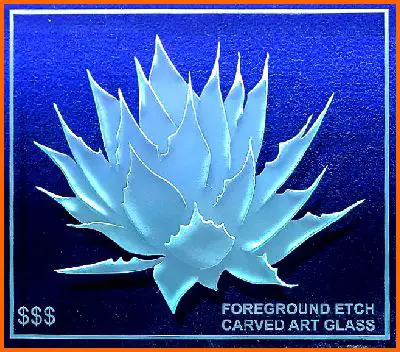
In carving, the edges of the drawing are sandblasted to a depth of 1/16″ or more. These deep edges create a 3-D, sculptural effect to the etching and, when illuminated from the side, refract light into the eyes of the viewer.
Choose carved glass if money is no object and you really want to impress the neighbors.
Deep carving with color
Etched glass is traditionally a black and white artform – but it is sometimes highly effective to add color.

This deeply carved dove has an aqua blue halo painted at the request of the customer. Also, note the polychrome (painted) olive branch and leaves. The dove is surrounded by vibrant yellow waterglass overlaid (plated) to the back of the panel.
Tell your glass artist which style (frosted, shaded, carved, or colored) you would like for your project.
Tips for collaborating with your glass artist
An experienced glass artist has designed hundreds of panels and can be your best resource in guiding you to the optimal design choice. Take her advice to avoid costly artistic blunders.
Avoiding the cliché! Your stained glass artist has made hundreds of panels and knows the importance of original designs. She can advise on the designs least likely to offend a future buyer of your home. It is very important to avoid the cliché – do not commission a coyote howling at the moon unlike you are being ironic!
Accentuate the positive! A great source of frustration for the dedicated glass artist is the customer who goes into great detail about what he does not want. Please concentrate on the positive – explain what you do want.
Have confidence in the artist but, if you want to enjoy the challenge of deciding your own design, follow these tips:
Trust your instincts – do not be afraid! Some customers know exactly what they want: a favorite flower like a rose, a bird such as a quail, or a memory evocative of an idyllic childhood.
Indulge your imagination and enjoy the process – the journey – of developing the ideal design for your home, church, or business. This comprehensive blog post gives general advice on how to design a SW-style etched glass window and this post explains how to choose between etched and stained glass for your home.
Use the search capabilities of the internet. If you have a favorite subject, the best approach is to do an internet image search. For example, if you like roses, search Google images for a term like “etched glass roses”. Use the results for ideas and forward your favorites to your glass artist to serve as inspiration.
Consider the function of the window
The purpose or function of the window will help you to narrow down the details of the design.
- Privacy
- View control
- Home improvement
- Beauty
The twin benefits of privacy and view control are the main reasons for choosing etched glass in the home. This comprehensive post explains these benefits in great detail. In brief, sandblasted/frosted glass obscures the view but still allows light to enter.
Customers can select exactly the right amount of obscurity to allow light to enter without permitting intruders to see inside. Privacy panels are especially useful in entryways and bathrooms.
The most important function of stained glass in modern homes is to provide privacy.
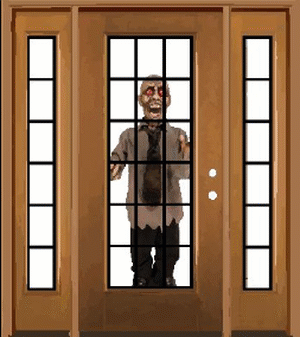

Customers can select exactly the right amount of obscurity to allow light to enter without permitting intruders to see inside. Privacy panels are especially useful in entryways and bathrooms.

Essential tip! – for privacy and view control make sure you choose a design with a frosted (obscure) background.
Use design style to narrow your choices
Even if you do not know the exact subject of the design you do have an idea of the style of your home interior.
You describe your home decorating style as eclectic but hard to pin down. Consider the following main categories and decide which is best for your project:-
- Traditional
- Southwestern
- Abstract/contemporary
- Mission/Frank Lloyd Wright
- Country/Art Nouveau
Use your design style to search Google images for ideas – specifically: search for “traditional-style etched glass”, “mission-style etched glass windows“, “contemporary-style etched glass windows”, “country-style etched glass windows”, “geometric-style” etc.
Decide which ideas you like best and forward them to your glass artist/designer.

Choose your design without considering colors. Etched glass is essentially a black and white artwork (although color is occasionally possible).
Production of your panel: once the design is finalized, be patient as your glass artist orders the glass and completes the sandblasting – then, prepare for the excitement of seeing the result!
5) Approve the finished panel
Carefully examine your panel before it is installed
You will be living with your etched glass work of art for many years so make sure you are happy with the panel before it is installed.
Most glass artists will invite you to take a look at the finished etched glass panel before it is installed. Make sure there are no obvious scratches or defects (remember that variations are part of the hand-etched nature of sandblasted glass – so do not be too picky).
Use this final review to satisfy yourself that you like the result before the expensive step of delivery and installation.
Remember that etched glass cannot be “un-etched” – but it may be possible to add details like denser frosting or an extra hummingbird for example. Let your artist know before the panel is installed.
6) Approve the installation
The moment of truth has arrived – you have approved the etched glass panel and are ready for the installation.
Two common installation situations
Older residences (the 1980s and before) often have single-pane windows (sometimes even plexiglass). These need to be removed and replaced by your new etched glass panel together with protective tempered glass.
Protective tempered glass
Newer homes have energy-efficient dual-pane windows – see image below. In this case, the stained glass can be installed with clips, up against the IG unit, on the inside of the window.

Plan for your installers to spend between one and three hours at your home depending on the details of the job. To facilitate the installation, please observe the following courtesies:
Clear the area of small children, dogs, cats, and other pets.
Resist the temptation to park a lazy-boy recliner in front of the window to observe the installation process (even the most rhinoceros-skinned worker is offended by intrusive supervision).
Make sure you are available to examine and “sign off” on the quality of the installation. Examine the glass in different lighting conditions – from the inside and outside and check for details like fingerprints trapped on the inside of the glass.
There is nothing worse for the conscientious installer than to be called all the way back to remove a small fingerprint on the glass.
Stand back and admire your mutual creation – the collaboration between you and your glass artist: the synthesis of your idea and vision – realized and interpreted by the art, craft, and dedication of a skilled artist/craftsman – a treasure for future generations.
Handy price calculators
Use this unique price estimation module to get a general idea of how the complexity of the design affects the cost of an etched glass panel. Enter the approximate width and height of your window to get price estimates.
Simple Designs
Clear background or frosted (for privacy)



Complex designs
Shaded and/or deep carved works of art


Remember that these pricing modules are just basic guides and do not include design fees and delivery/installation charges. They also don’t take into account special procedures like adding protective glass, glass painting, glass fusing, or gilding.
For more details on etched glass pricing – read this comprehensive post.
Types of glass used for etching
Glass color or tint: most glass etching is done on so-called “clear” float glass which has a pale green tint owing to a small content of iron, but pleasing results can also be achieved on bronze or gray glass. Check this post to learn about tinted architectural glass.
Glass thickness: any thickness from 1/8″ up to 3/4″ glass can be etched, but, in practice, smaller panels like cabinet inserts are etched on 1/8″ glass, medium-size panels on 3/16″ to 1/4″ glass, and large panels, for shower enclosures, for example, are done on 3/8″ or 1/2″ glass.
Use the tucsontabletops.com website to calculate retail pricing for architectural glass.
Glass type – annealed or tempered: architectural glass starts out annealed and can be tempered or “heat-strengthened” to make safety glass. Learn how glass is tempered in this post.
Most residential glass panels are tempered so that, if they break, they shatter into harmless “popcorn” fragments – thus avoiding the danger of serious injury. Artistry in Glass has found it safe to sandblast tempered glass providing it is not deeply carved.
Single or dual-pane: frosting glass by sandblasting creates a porous surface that is vulnerable to staining by fingerprinting. For this reason it is always advisable to protect the frosted surface, especially when the background is frosted for privacy.
Protection method #1: create a dual paned unit. When replacing old, single-paned, panels – we highly recommend creating a dual-pane unit with the etched surface placed on one of the interior surfaces.
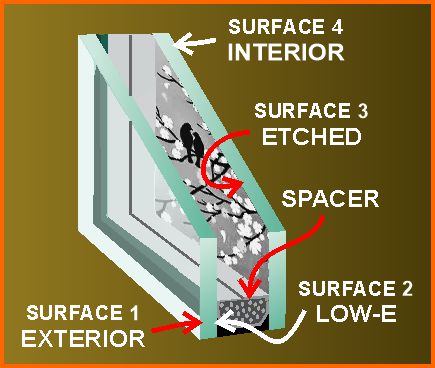
By incorporating low-E glass on surface #2 and etched glass on surface #3, a very efficient dual-pane unit is created.
Protection method #2: install the frosted surface on the window interior, up against an existing dual-pane unit.
Shower doors and enclosures: to guard against damage by water staining – always install shower glass with the etching on the outside (dry side).

Size and shape of windows
Measure your windows (to the nearest inch or two is OK) and use your cell phone to take photos. It’s helpful for the studio to see an overall view of the window in the context of the room and surroundings. Also, take a closeup to show the window framing. This will enable the studio to explain the recommended method of installation.
All you need to know about art glass
Commissioning stained and etched glass
- Stained glass designs from Artistry in Glass
- How to commission a stained glass window – complete advice
- How to commission an etched glass window
- How to choose the best stained glass design
- Etched or stained glass – which is better for your home?
- How much does stained glass cost?
- How much does etched glass cost?
Technical information
- Is leaded glass dangerous? Learn the facts.
- How to replace broken patio table glass
- Plexiglass and glass – what are the pros and cons?
- What is plexiglass used for?
- What costs more – glass or plexiglass?
- Preservation of stained glass in churches & synagogues
- How does stained glass get colored? learn from an expert!
- Is your broken stained glass panel worth repairing?
- How to protect stained glass in religious buildings
- How to care for and clean stained glass
- How to repair cracked stained glass
- What is Dalle de Verre?
- How to repair Dalle de Verre
- What to do about bowed & sagging stained glass
- How to care for a stained glass skylight
- Can my stained glass lampshade be repaired?
- What is the difference between sandblasting & etching?
- Obscure and frosted glass – all you need to know!
- How to save money when buying glass
- Glossary of important terms used in decorative glass
- 14 Ways to sell stained glass
- What is imitation or faux stained glass?
Guides to stained glass design
- Guide for designing abstract stained glass
- Why choose abstract contemporary stained glass
- How to design a Frank Lloyd Wright-style window
- Designing a WWII-era stained glass Waco glider
- Stained glass and Black Lives Matter
- How Is stained glass used today?
Artistry in Glass was your source for antique repair in Tucson
Check out this amazing selection of informative articles:-
- Where can I get antiques repaired?
- Are broken antiques worth fixing?
- How to fix a broken picture frame
- How to repair a broken china plate
- How to repair a broken china teapot
- How to fix a broken marble slab
- How to repair a broken china coffee mug
- How to repair a 2000-year-old sculpture
- All about repairing stained-glass lampshades
- How to care for your stained glass skylight
- How to repair Dalle de Verre
- Is stained glass worth repairing?
- To repair or toss out?
- Tucson crystal & china repair a division of Artistry in Glass
- What to do with broken antiques
- Is lead crystal dangerous?
- Repairing an antique Mexican statue
- Repairing religious statues
- The history of Swarovski crystal figurines
- How to find the value of a Swarovski Crystal figurine
- Have Swarovski crystal figurines lost value since 2009?
- How to collect Swarovski annual ornaments
- How to display Swarovski crystal figurines
- How to authenticate a Swarovski crystal figurine
- How to display Swarovski annual ornaments
- How to clean Swarovski crystal figurines
- How to repair a Swarovski crystal mouse
- How to repair a Swarovski annual ornament
- How to repair a Swarovski crystal train set
- Fixing broken wine glass stems
- How to clean cloudy glasses
- Why do wine glasses have stems?
- Swarovski Crystal Figurines
- How to repair a chip in a wine glass
- How to fix a scratched glass tabletop
- How to replace a broken patio tabletop
Unique Mirror Resources from Artistry in Glass
Mirror Design & layout
- How are mirrors made?
- What is a beveled mirror?
- What is a two-way mirror?
- Best mirrors for bedrooms
- How to size and position your wall mirror
- How to order custom etched mirrors
- Best places to hang dining room mirrors
- How much do wall mirrors cost?
- Shop the MIRROR Family Package
Mirror Installation & Removal
- How to hang a wall mirror
- How to frame a builder’s grade bathroom mirror
- How to hang a frameless mirror with glue
- Best clips for hanging mirrors
- How to attach a mirror to a closet door
- How to remove a mirror glued to the wall

